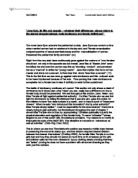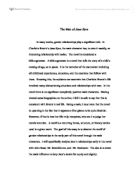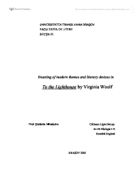How is happiness conveyed in Jane Austen's Emma and Charlotte Bronte's Villette?
"Some real lives do - for some certain days or years - actually anticipate happiness of heaven" - Lucy Snowe How is happiness conveyed in Jane Austen's Emma and Charlotte Bronte's Villette? The nineteenth century was an era of great discovery, invention and social change as a result of political unrest in the previous years. The American Revolution which culminated in the United States Declaration of Independence, lead to a change in political thought, bringing ideas of 'Life, Liberty and the Pursuit of Happiness' (1776: line4), though how much this extended to women is debateable. Published thirty-seven years apart, Emma and Villette tell the stories of two girls trying to find happiness in difficult societies. The two lead characters are very different; Emma is a respected, wealthy and attractive young woman yet rather spoilt, whereas Lucy Snowe is passive and secretive, with no significant amount of money or family connections. Living in the same century, therefore, it would seem safe to assume that the girls would find happiness in the same things; good company, money and a happy marriage. As Philip Davis argues, Victorian novels (though Emma predates Victoria's reign by approximately twenty years) were concerned only with 'Humanity, Duty, Vocation, Work, Marriage [and] Family' (2002:2). However, this is not the case for either of the girls. Lucy finds comfort
The narrative of popular romance simultaneously challenges and reaffirms traditional male-female rel
The narrative of popular romance simultaneously challenges and reaffirms traditional male-female rel The theory that popular art as a whole exists to reinforce the status quo and keep its audience happy with it is one that has long been espoused by critics. This attitude is one which was especially championed by the Marxist oriented Frankfurt school of thought led by Horkheimer, Adorno and Herbert Marcuse, who argued that only "high" art could give us a view of a better tomorrow. In her book "Loving with a Vengeance"(-henceforth referred to as LWAV) Tania Modleski argues that, in this sense, contempt for 'mass' art is seen as a politically pro~ressive attitude (pg.30) Howeve~ she goes on to say that Robert Jameson showed that mass art often contained many specific criticisms of ~everyday life.Therefore, in order to effectively answer the question above the extent to which the popular romance criticises or celebrates the traditional relations between the sexes must be determined. In this essay I will attempt to examine this closely, looking firstly at how far the novels in question can be said to be reaffirming the traditional roles between the sexes then going on to examine the possible challenges they offer. It would be useful to firstly ascertain what is meant by the traditional relations between the sexes." The hero in Mills and Boon and Harlequin novels must be, in order
Through her stories, "The Yellow Wallpaper" and "Making a Change," Charlotte Perkins Gilman portrays two contrasting views of women in similarly restrictive circumstances.
Stella Dubish ENG243 Dr. S. Orr, Professor April 20, 2001 The Choice Through her stories, "The Yellow Wallpaper" and "Making a Change," Charlotte Perkins Gilman portrays two contrasting views of women in similarly restrictive circumstances. Both the women are young mothers with creative talents that are being squelched by their husbands and families. The difference lies in what the two women do within these contexts. While one woman takes control of the situation, ultimately renewing and empowering herself, the other submits to the forces pushing against her, eventually going crazy. In "The Yellow Wallpaper," a woman, Jane, struggles for mental independence. She has been diagnosed with "temporary nervous depression" by her husband, who is a doctor. She purports, however, that she is neither nervous nor depressed. She simply wants mental and social stimulation, both of which are not being allowed her because of her "condition." Instead of receiving visitors and enjoying the countryside, Jane is confined to a room that used to be a nursery. This is just one of the evidences of how she is treated like a child throughout the whole story. The one characteristic of the room that haunts Jane is the wallpaper - it is yellow, grotesque and glaring. She spends her spare time watching it and writing about it. The color and pattern intrigue her so much that she cannot
Compare and Contrast the Techniques Used by Bronte in Describing Thornfiled Hall in Chapter 11, with those used by Woolf in Describing London in the Early Pages of Mrs. Dalloway
Compare and Contrast the Techniques Used by Bronte in Describing Thornfiled Hall in Chapter 11, with those used by Woolf in Describing London in the Early Pages of Mrs. Dalloway? Jane Eyre's tone is both gothic and romantic, often conjuring an atmosphere of mystery and secrecy. Her description of Thornfield in chapter 11, is very Victorian and thorough, which draws us into the novel. On page 122 of Chapter 11, when approaching the third floor, Jane uses a visual first person narrative text. When Bronte writes, "Mrs Fairfax stayed behind a moment to fasten the trap-door", she is giving us an aspect of ambiguity, the word 'fasten' emphasises the refusal of entry. The description of the staircase in Thornfield Hall illustrates the rigid and constricted atmosphere, as they are described as 'the narrow garret staircase'. Bronte uses alliteration when stating, "lingered in the long passage", to emphasise the description of her movement in the surroundings. The phrase 'separating' used in the passage exemplifies the secrecy within Thornfield, which also intrigues us. The use of semicolons and commas in the passage, adds to the appeal of Thornifield, illustrated when Bronte writes, "the third story; narrow, low, and dim". These techniques disrupt the flow of the sentence to show the fascination and anxiety that she has for the attic. This allows the structure of the sentence to be
Jane Eyre, its film and sequels whatever their differences- always return to the eternal struggle between male dominance and female victimhood
"Jane Eyre, its film and sequels - whatever their differences- always return to the eternal struggle between male dominance and female victimhood" The novel Jane Eyre subverts the patriarchal society. Jane Eyre was wrote in a time when married women had no existence in the law and, and "female emancipation conjured spectres of sexual permissiveness and the masculinisation of women, threatened the patriarchal family and state" (xv). Right from the very start Jane continuously goes against the customs of how females should act, not only to the opposite sex but overall. Jane flies at "Master John" when he strikes her and even the women saw this as "shocking conduct", and perceived her as a "mad cat" to strike her "young master". Jane then replies that he is not her master and she is not a servant, to then hear that she is "less than a servant" (15). This is the first time we see Jane go against male dominance and this outburst ends in her been imprisoned because of her acts. Thus proving that male dominance is acceptable but a female has to take it dutifully to resist further punishment. The battle of dominancy continues at Lowood. This section not only shows a clash of dominance but it shows also what "class" you are, really has a difference on how a female body should be presented. We see throughout this section, Jane, Helen, and Miss Temple all fight against
Jane Eyre- Analysis.
Jane Eyre - Analysis Immediately the reader is positioned on Jane's side through careful novelistic craftsmanship. From the first page, Jane is oppressed, sent off while her cousins play. We learn through exposition from John that she is a penniless orphan, dependent on the heartless Reed family; indeed, social class will play an important role in the rest of the novel. She is also a sensitive girl given to flights of fancy while reading, but she also displays her strength in her defense against John. All the elements are in place for a classic "Bildungsroman," the literary genre originating in the German literally as "novel of formation" or, as it is generally known, the "coming-of-age" story. In the Bildungsroman, classic examples of which are Goethe's The Sorrows of Young Werther, Mark Twain's Huckleberry Finn, and J.D. Salinger's The Catcher in the Rye, the young protagonist matures through a series of obstacles and defines his or her identity. The red-room has both deathly associations (red as the color of blood, the room's containing a miniature version of the dead Mr. Reed, and Jane's belief that she sees a ghost in it) and is a clear symbol of imprisonment. Throughout the novel, Jane will be imprisoned in more metaphorical ways, particularly relating to class, gender, and religion. Ironically, although John is the root cause of Jane's imprisonment here, the three
The Men of Jane Eyre.
The Men of Jane Eyre In many works, gender relationships play a significant role. In Charlotte Bronte's Jane Eyre, the main character has, to state it meekly, an interesting relationship with males. The novel is considered a bildungsroman. A bildungsroman is a novel that tells the story of a child's coming of age, so to speak. It is the narration of the maturation including all childhood experiences, situations, and the emotions that follow with them. Knowing this, the audience can ascertain that Charlotte Bronte's life involved many disheartening situations and relationships with men. In the novel there is no significant completely positive male characters. Having viewed some biographies on the author, I fell it is safe to say that this is consistent with Bronte's real life. Being a male, I must state that the novel is upsetting in the fact that it appears at first glance to be quite feminist. However, if that is how her life truly transpired, who am I to judge her novels intention. A motif is a recurring theme, structure, or literary device used in a given work. The goal of this essay is to observe the motif of gender relationships in the early part of this novel through the male characters. I will specifically analyze Jane's relationships early in the novel with John Reed, Mr. Brocklehurst, and Mr. Rochester. The aim is to show the male influence to deny
Enacting of modern themes and literary devices in To the Lighthouse by Virginia Woolf.
UNIVERSITATEA TRANSILVANIA BRASOV FACULTATEA DE LITERE SECTIA ID Enacting of modern themes and literary devices in To the Lighthouse by Virginia Woolf Prof. Stefania Mihalache Catinean Ligia Danuta An III Filologie I D Româna-Engleza BRASOV 2003 To the Lighthouse by Virginia Woolf In two of her essays Modern Fiction and Mr. Bennett and Mrs. Brown she said that the novels are a protest to traditional novel which really too much on the exterior reality on the surface. Virginia Woolf found necessary to create new methods and techniques, to invent a new form of novel, capable of expressing her own vision of life. She is interested in finding what is beyond things, in finding the essential truth of life. Her novels attempt both to "dissipate" character and to reintegrate human experience within an aesthetic shape or form. She seeks to represent the nature of transient sensation, or of conscious and unconscious mental activity, and then to relate it outwards to more universal awareness of pattern and rhythm. The momentary reaction, the impermanent emotions, the ephemeral stimulus, the random suggestion, and the dissociated thought are effectively 'bent' into a stylistic relationship to something coherent and structured. The characters may often seem to be dissolved into little more than ciphers, what they come to signify is part of complex iconographic
Discuss the role of the narrator in Die Verwandlung.
Discuss the role of the narrator in Die Verwandlung. In this essay I shall look at the role of the narrator in the book Die Verwandtlung and discuss what effect it has on the way the story is told. I shall firstly look at the narration and discuss what form it takes, then I shall consider ideas about what effect it has, looking for examples in the book. I shall conclude by summarising the main points as to what form the narration takes and what effect it seems to have overall in the book. In the book the form that the narration takes is a complex one. It changes between a 3rd person narrator, focalised through Gregor Samsa and the seeming thoughts of Samsa himself. For example, in the second section we can see that the narrator only knows what Gregor can find out: "Mit welchen Ausreden man an jenem ersten Vormittag den Arzt und den Schlosser wieder aus der Wohnung geschafft hatte, konnte Gregor gar nicht erfahren..." However, at various times throughout the book the narrative lapses into thoughts that Gregor would probably be having. Like when he looks at the alarm clock on the first morning and sees that it is very late: "Sollte der Wecker nicht geläutet haben?...Ja, aber war es möglich, dieses möbelerschütternde Läuten ruhig verschlafen? Nun, ruhig hatte er ja nicht geschlafen, aber wahrscheinlich detso fester." This shows that the narrative is still in the
Journal 1 – The Metamorphosis
Jean Benoit Lauzon 05/11/01 English journals - Kafka Journal 1 - The Metamorphosis The opening paragraph of this short story begins with the introduction of Gregor Samsa as a newly transformed insect. The narrator's intent in regards to this brusque stating of Gregor's new physical shape, is perhaps to convey Gregor's own surprised and confused feelings into the reader's mind. The narrator seems to anticipate what the reader is thinking, as he immediately states that Gregor is transformed, and what shape he now possesses. The narrator pushes his description to unfolding the exact contours of Gregor's body. He takes the perspective of Gregor, looking down on his own body, perhaps to heighten the vividness and brutal psychological shock of the first vision of his "numerous legs, which were pitifully thin compared to the rest of his bulk, waved helplessly before his eyes." The reader is thus enabled, through this first-person point-of-view, to visualise that precise image, which inherently helps the reader better understand the effect of the transformation through Gregor's perspective. The paragraph detailing Gregor's metamorphosis is followed by a description of his room and of his non-bug life. The reader notices that where the first paragraph was leaning towards structure and a coherent and precise description of Gregor, this paragraph seems to consist of











